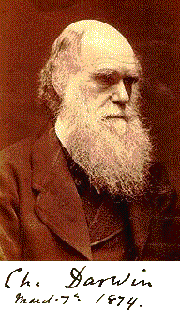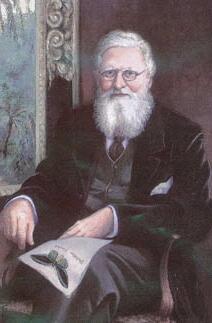First Edition -- 1859
Organs of extreme perfection and complication.
To suppose that the eye, with all its inimitable contrivances for adjusting the focus to different distances, for admitting different amounts of light, and for the correction of spherical and chromatic aberration, could have been formed by natural selection, seems, I freely confess, absurd in the highest possible degree.
Yet reason tells me, that if numerous gradations from a perfect and complex eye to one very imperfect and simple, each grade being useful to its possessor, can be shown to exist; if further, the eye does vary ever so slightly, and the variations be inherited, which is certainly the case; and if any variation or modification in the organ be ever useful to an animal under changing conditions of life, then the difficulty of believing that a perfect and complex eye could be formed by natural selection, though insuperable by our imagination, can hardly be considered real.
How a nerve comes to be sensitive to light, hardly concerns us more than how life itself first originated; but I may remark that several facts make me suspect that any sensitive nerve may be rendered sensitive to light, and likewise to those coarser vibrations of the air which produce sound.
In looking for the gradations by which an organ in any species has been perfected, we ought to look exclusively to its lineal ancestors; but this is scarcely ever possible, and we are forced in each case to look to species of the same group, that is to the collateral descendants from the same original parent-form, in order to see what gradations are possible, and for the chance of some gradations having been transmitted from the earlier stages of descent, in an unaltered or little altered condition. Amongst existing Vertebrata, we find but a small amount of gradation in the structure of the eye, and from fossil species we can learn nothing on this head. In this great class we should probably have to descend far beneath the lowest known fossiliferous stratum to discover the earlier stages, by which the eye has been perfected.
In the Articulata we can commence a series with an optic nerve merely coated with pigment, and without any other mechanism; and from this low stage, numerous gradations of structure, branching off in two fundamentally different lines, can be shown to exist, until we reach a moderately high stage of perfection. In certain crustaceans, for instance, there is a double cornea, the inner one divided into facets, within each of which there is a lens-shaped swelling. In other crustaceans the transparent cones which are coated by pigment, and which properly act only by excluding lateral pencils of light, are convex at their upper ends and must act by convergence; and at their lower ends there seems to be an imperfect vitreous substance.
With these facts, here far too briefly and imperfectly given, which show that there is much graduated diversity in the eyes of living crustaceans, and bearing in mind how small the number of living animals is in proportion to those which have become extinct, I can see no very great difficulty (not more than in the case of many other structures) in believing that natural selection has converted the simple apparatus of an optic nerve merely coated with pigment and invested by transparent membrane, into an optical instrument as perfect as is possessed by any member of the great Articulate class.
He who will go thus far, if he find on finishing this treatise that large bodies of facts, otherwise inexplicable, can be explained by the theory of descent, ought not to hesitate to go further, and to admit that a structure even as perfect as the eye of an eagle might be formed by natural selection, although in this case he does not know any of the transitional grades. His reason ought to conquer his imagination; though I have felt the difficulty far too keenly to be surprised at any degree of hesitation in extending the principle of natural selection to such startling lengths.
It is scarcely possible to avoid comparing the eye to a telescope. We know that this instrument has been perfected by the long-continued efforts of the highest human intellects; and we naturally infer that the eye has been formed by a somewhat analogous process. But may not this inference be presumptuous? Have we any right to assume that the Creator works by intellectual powers like those of man? If we must compare the eye to an optical instrument, we ought in imagination to take a thick layer of transparent tissue, with a nerve sensitive to light beneath, and then suppose every part of this layer to be continually changing slowly in density, so as to separate into layers of different densities and thicknesses, placed at different distances from each other, and with the surfaces of each layer slowly changing in form.
Further we must suppose that there is a power always intently watching each slight accidental alteration in the transparent layers; and carefully selecting each alteration which, under varied circumstances, may in any way, or in any degree, tend to produce a distincter image. We must suppose each new state of the instrument to be multiplied by the million; and each to be preserved till a better be produced, and then the old ones to be destroyed. In living bodies, variation will cause the slight alterations, generation will multiply them almost infinitely, and natural selection will pick out with unerring skill each improvement.
Let this process go on for millions on millions of years; and during each year on millions of individuals of many kinds; and may we not believe that a living optical instrument might thus be formed as superior to one of glass, as the works of the Creator are to those of man?
If it could be demonstrated that any complex organ existed, which could not possibly have been formed by numerous, successive, slight modifications, my theory would absolutely break down. But I can find out no such case. No doubt many organs exist of which we do not know the transitional grades, more especially if we look to much-isolated species, round which, according to my theory, there has been much extinction. Or again, if we look to an organ common to all the members of a large class, for in this latter case the organ must have been first formed at an extremely remote period, since which all the many members of the class have been developed; and in order to discover the early transitional grades through which the organ has passed, we should have to look to very ancient ancestral forms, long since become extinct.
|
Sixth Edition -- 1872
Organs of extreme perfection and complication.
To suppose that the eye with all its inimitable contrivances for adjusting the focus to different distances, for admitting different amounts of light, and for the correction of spherical and chromatic aberration, could have been formed by natural selection, seems, I freely confess, absurd in the highest degree. When it was first said that the sun stood still and the world turned round, the common sense of mankind declared the doctrine false; but the old saying of Vox populi, vox Dei, as every philosopher knows, cannot be trusted in science. Reason tells me, that if numerous gradations from a simple and imperfect eye to one complex and perfect can be shown to exist, each grade being useful to its possessor, as is certainly the case; if further, the eye ever varies and the variations be inherited, as is likewise certainly the case; and if such variations should be useful to any animal under changing conditions of life, then the difficulty of believing that a perfect and complex eye could be formed by natural selection, though insuperable by our imagination, should not be considered as subversive of the theory.
How a nerve comes to be sensitive
to light, hardly concerns us more than how life itself originated; but I
may remark that, as some of the lowest organisms in which nerves cannot be
detected, are capable of perceiving light, it does not seem impossible that
certain sensitive elements in their sarcode should become aggregated and
developed into nerves, endowed with this special sensibility.
In searching for the gradations through which an organ in any species has
been perfected, we ought to look exclusively to its lineal progenitors; but
this is scarcely ever possible, and we are forced to look to other species
and genera of the same group, that is to the collateral descendants from
the same parent-form, in order to see what gradations are possible, and for
the chance of some gradations having been transmitted in an unaltered or
little altered condition. But the state of the same organ in distinct
classes may incidentally throw light on the steps by which it has been
perfected.
The simplest organ which can be called an eye consists of an optic nerve,
surrounded by pigment-cells and covered by translucent skin, but without
any lens or other refractive body. We may, however, according to M.
Jourdain, descend even a step lower and find aggregates of pigment-cells,
apparently serving as organs of vision, without any nerves, and resting
merely on sarcodic tissue. Eyes of the above simple nature are not capable
of distinct vision, and serve only to distinguish light from darkness. In
certain star-fishes, small depressions in the layer of pigment which
surrounds the nerve are filled, as described by the author just quoted,
with transparent gelatinous matter, projecting with a convex surface, like
the cornea in the higher animals. He suggests that this serves not to form
an image, but only to concentrate the luminous rays and render their
perception more easy. In this concentration of the rays we gain the first
and by far the most important step towards the formation of a true,
picture-forming eye; for we have only to place the naked extremity of the
optic nerve, which in some of the lower animals lies deeply buried in the
body, and in some near the surface, at the right distance from the
concentrating apparatus, and an image will be formed on it.
In the great class of the Articulata, we may start from an optic nerve
simply coated with pigment, the latter sometimes forming a sort of pupil,
but destitute of lens or other optical contrivance. With insects it is now
known that the numerous facets on the cornea of their great compound eyes
form true lenses, and that the cones include curiously modified nervous
filaments. But these organs in the Articulata are so much diversified that
Muller formerly made three main classes with seven subdivisions, besides a
fourth main class of aggregated simple eyes.
When we reflect on these facts, here given much too briefly, with respect
to the wide, diversified, and graduated range of structure in the eyes of
the lower animals; and when we bear in mind how small the number of all
living forms must be in comparison with those which have become extinct,
the difficulty ceases to be very great in believing that natural selection
may have converted the simple apparatus of an optic nerve, coated with
pigment and invested by transparent membrane, into an optical instrument as
perfect as is possessed by any member of the Articulata class.
He who will go thus far, ought not to hesitate to go one step further, if
he finds on finishing this volume that large bodies of facts, otherwise
inexplicable, can be explained by the theory of modification through
natural selection; he ought to admit that a structure even as perfect as an
eagle's eye might thus be formed, although in this case he does not know
the transitional states. It has been objected that in order to modify the
eye and still preserve it as a perfect instrument, many changes would have
to be effected simultaneously, which, it is assumed, could not be done
through natural selection; but as I have attempted to show in my work on
the variation of domestic animals, it is not necessary to suppose that the
modifications were all simultaneous, if they were extremely slight and
gradual. Different kinds of modification would, also, serve for the same
general purpose: as Mr. Wallace has remarked, "If a lens has too short or
too long a focus, it may be amended either by an alteration of curvature,
or an alteration of density; if the curvature be irregular, and the rays do
not converge to a point, then any increased regularity of curvature will be
an improvement. So the contraction of the iris and the muscular movements
of the eye are neither of them essential to vision, but only improvements
which might have been added and perfected at any stage of the construction
of the instrument." Within the highest division of the animal kingdom,
namely, the Vertebrata, we can start from an eye so simple, that it
consists, as in the lancelet, of a little sack of transparent skin,
furnished with a nerve and lined with pigment, but destitute of any other
apparatus. In fishes and reptiles, as Owen has remarked, "The range of
gradation of dioptric structures is very great." It is a significant fact
that even in man, according to the high authority of Virchow, the beautiful
crystalline lens is formed in the embryo by an accumulation of epidermic
cells, lying in a sack-like fold of the skin; and the vitreous body is
formed from embryonic subcutaneous tissue. To arrive, however, at a just
conclusion regarding the formation of the eye, with all its marvellous yet
not absolutely perfect characters, it is indispensable that the reason
should conquer the imagination; but I have felt the difficulty far to
keenly to be surprised at others hesitating to extend the principle of
natural selection to so startling a length.
It is scarcely possible to avoid comparing the eye with a telescope. We
know that this instrument has been perfected by the long-continued efforts
of the highest human intellects; and we naturally infer that the eye has
been formed by a somewhat analogous process. But may not this inference be
presumptuous? Have we any right to assume that the Creator works by
intellectual powers like those of man? If we must compare the eye to an
optical instrument, we ought in imagination to take a thick layer of
transparent tissue, with spaces filled with fluid, and with a nerve
sensitive to light beneath, and then suppose every part of this layer to be
continually changing slowly in density, so as to separate into layers of
different densities and thicknesses, placed at different distances from
each other, and with the surfaces of each layer slowly changing in form.
Further we must suppose that there is a power, represented by natural
selection or the survival of the fittest, always intently watching each
slight alteration in the transparent layers; and carefully preserving each
which, under varied circumstances, in any way or degree, tends to produce a
distincter image. We must suppose each new state of the instrument to be
multiplied by the million; each to be preserved until a better is produced,
and then the old ones to be all destroyed. In living bodies, variation
will cause the slight alteration, generation will multiply them almost
infinitely, and natural selection will pick out with unerring skill each
improvement.
Let this process go on for millions of years; and during each
year on millions of individuals of many kinds; and may we not believe that
a living optical instrument might thus be formed as superior to one of
glass, as the works of the Creator are to those of man?
Modes of Transition.
If it could be demonstrated that any complex organ existed, which could not
possibly have been formed by numerous, successive, slight modifications, my
theory would absolutely break down. But I can find out no such case. No doubt many organs exist of which we do not know the transitional grades,
more especially if we look to much-isolated species, around which,
according to the theory, there has been much extinction. Or again, if we
take an organ common to all the members of a class, for in this latter case
the organ must have been originally formed at a remote period, since which
all the many members of the class have been developed; and in order to
discover the early transitional grades through which the organ has passed,
we should have to look to very ancient ancestral forms, long since become
extinct.
|


 Where'd You Get Those Peepers : There has been enough time for eyes to evolve from scratch 1,500 times within any one lineage. Time, far from stretching credulity with its vastness, turns out to be too short for geologists to measure! It is a geological blink.
Where'd You Get Those Peepers : There has been enough time for eyes to evolve from scratch 1,500 times within any one lineage. Time, far from stretching credulity with its vastness, turns out to be too short for geologists to measure! It is a geological blink.